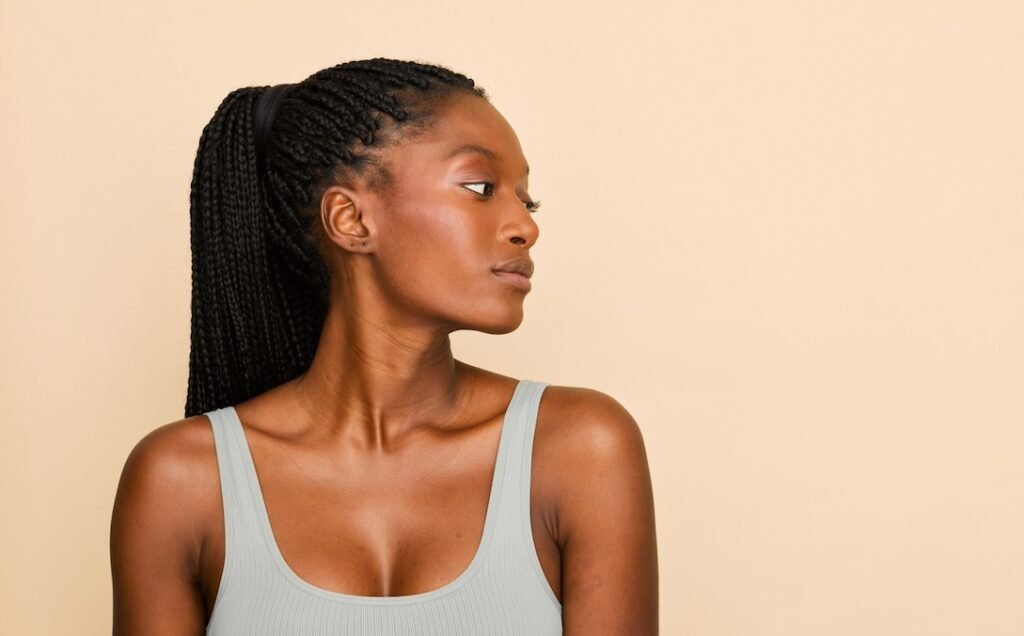I first tried wearing braids as a form of protection during the pandemic. This style helped me maintain thick, curly hair when I couldn’t get my fortnightly salon blowouts during lockdown. I chose long-term box braids– Smooth, thick and ropey – similar to the version worn by Janet Jackson poetic justice.
In addition to helping me look and feel put together with minimal effort, the benefits of effortless box braids can’t be overstated. For me, minimalist styles are perfect because I’m a low-maintenance woman who wants an effortless style that looks classy. I love the freedom they give me. I no longer have to spend 20 minutes a day meticulously combing and styling my textured hair. Instead, I can get up quickly and go about my business, enjoying the precious time I save instead of being at the mercy of my hair.
So even if salons reopened, I had no hesitation in keeping my braided hairstyle. I get my box braids professionally redone every eight to ten weeks. However, after 18 months of wearing braids, I noticed that the edges of my braids were getting thinner. “To me, this looks like traction alopecia,” a professional hairstylist told me while inspecting my fragile hairline during an appointment, ultimately making me question whether my choice of protection was “protective.” . The reality is that any hairstyle that creates tension at the roots of your hair (such as braids, buns, ponytails, tight scrunchies, etc.) can put you at risk for hair loss, shedding, or in more severe cases, traction alopecia.
To help me figure out if traction alopecia was the cause of my thinning edges, I contacted Carl Truesdale, MD, a board-certified facial plastic surgeon and hair transplant surgeon Dr. Hadley King, MD, board-certified dermatologist; talks with trichologists Bridgette Hill and Sophia Emmanuel about all things traction alopecia, including how to recognize it, how to prevent it, and how to regrow hair after hair loss.
What is traction alopecia?
Traction alopecia is hair loss caused by repeated pulling or tension on the scalp. According to Dr. Truesdale, excessive stress on hair follicles is very common due to the growing popularity of braids, extensions, wigs, and pulled-back hairstyles like buns and ponytails. although anyone You may experience traction alopecia, a condition that is common among black women and affects one in three women, According to research. “Traction alopecia can affect any area of the scalp that is stretched, but it primarily affects the hairline, crown of the head, and nape of the neck,” Emanuel tells us. “Over time, prolonged use of high-tension hairstyles may lead to permanent hair loss due to irreversible damage to hair follicles.”
Dr. Truesdale says the culprit in traction alopecia is often chronic inflammation of the hair follicles that occurs when hair is pulled too tight. “Ongoing inflammation can lead to thinning, breakage, and ultimately baldness in the affected area,” he says.
What are the causes of traction alopecia?
Any hairstyle that excessively pulls or puts pressure on the scalp can lead to traction alopecia. These styles can also include what some call “protective styles,” including braids, twists, braids, braids, extensions, buns, and ponytails that are too tight. “If done incorrectly, they are no longer considered protective,” Hill said. “They’re more of a ‘convenience style,’ because if they’re made too tight, you can do more harm than good.” Hill also says that using bulky extension cords with some guard styles can put physical stress on your strands, Because they will get stressed and eventually pull them out. “Be careful when adding hair to your style that it doesn’t have to be heavy or have a lot of weight,” she warns.
Emanuel also said clip-in hair extensions can cause traction alopecia by repeatedly pulling and compressing the scalp, which can weaken hair follicles over time if done repeatedly. Likewise, an ill-fitting wig—”whether it’s too small or too loose”—can cause friction on your edges and lead to hair loss,” she adds, noting that the glue used to secure the wig may also help make your hair fall out. The natural hairline is thinning.
What are the symptoms of traction alopecia?
Early symptoms of traction alopecia include an itchy, tender or red scalp, small pimple-like bumps at the hairline and temples due to traction tension, and hair breakage, Dr. Truesdale said. “As the disease progresses, the hair becomes thinner and thinner, and in severe cases, the hair follicles are permanently damaged,” he said. Often, when diagnosing traction alopecia, damage to the hair follicles is visually apparent, Dr. King said. However, a doctor can perform a biopsy to rule out other possibilities for hair loss.
How is traction alopecia treated?
“If you suspect you may have traction alopecia, be sure to talk to a health care professional or dermatologist,” says Dr. Truesdale. “Early diagnosis and treatment can help reduce hair loss and improve overall hair health.”
First – loosen up your tight style
Hill says the first step to recovery is to stop wearing flawed hairstyles or using harmful methods that strain your hair or cause excessive friction, which can relieve tension on the hair follicles. This doesn’t mean never to wear a ponytail or box braid again, but if the hair tie is pulling on your roots, stop and take a minute to loosen it (or take it out before bed), and if you The situation needs to be communicated with the braider and hairstylist.
Practices such as sleeping on a silk pillowcase to minimize extra friction or making sure the straps on your hat are not too tight can also help, as well as using gentle, nourishing hair products. “Hair loss doesn’t happen the first time you get a hair tie. Hair loss happens over time. So if you can keep your scalp healthy, you can get your hair back to normal,” explains Dr. King. For more severe cases, medical intervention may be needed, and treatment depends on the severity of the hair loss, Dr. Truesdale said.
Discuss medication options with your doctor
If scarring of the hair follicles is not involved, the FDA-approved topical medication minoxidil can help stimulate hair growth. Minoxidil works by improving blood flow to the scalp, which in turn helps keep hair in the anagen (the growth phase of hair) longer. to improve its efficacy and scalp absorption. Additionally, doctors can inject topical corticosteroids (such as FDA-approved injections) kennalogue) into the affected area to reduce inflammation caused by the condition.
In conjunction with the previously mentioned scalp treatments, Dr. Truesdale also likes to treat damaged areas with red light therapy, Platelet Rich Plasma Therapy (also called PRP), or exosome injection Promotes scalp health and hair follicle recovery. red light therapy The principle is to expose hair loss areas to red LED lights to promote dormant hair follicles to enter the growth stage.
PRP involves drawing blood from the patient and isolating the enriched cells, which are then injected into the scalp to feed damaged hair follicles and stimulate their stem cells to promote hair growth. Exosome therapy, on the other hand, is a newer scalp treatment that helps restore dormant hair follicles to their normal state. Exosomes contain growth factors, various proteins and activated stem cell signals that can communicate with damaged hair follicle cells to stimulate hair regeneration.
However, Dr. King explains that if the damage to the hair follicles is severe enough to cause scarring, the resulting hair loss will be permanent. “There’s nothing you can do at that stage to turn things around,” she told us. Therefore, if this is the case, a hair transplant may be your only viable option. Dr. Truesdale explains that the procedure involves transferring healthy hair follicles from areas on the back or sides of the scalp (where hair is typically less susceptible to baldness) to fill in the areas experiencing irreversible hair loss by replacing them with new hair.
What can we do to prevent traction alopecia?
Dr. Truesdale advises that the best way to avoid traction alopecia is to avoid tight hairstyles at all. Hill recommends choosing a loose style to reduce tension on your hair. If you wear hair extensions, braids, wigs, clips, braids or braids, make sure they are not too tight, wear them moderately, and change your style often to give your hair follicles a rest.
Remember, when choosing a braiding specialist, look for a licensed hairstylist or experienced artist whose techniques can minimize scalp irritation. The bottom line, Hill says, is don’t be afraid to speak up if you feel discomfort and ask them to cancel the styling immediately if it hurts. We know it can be a little awkward to push back in the salon chair, but speaking up at the first sign of discomfort can save you a lot of stress and pain in the long run.
final gain
Armed with the above information, I stopped braiding my hair as frequently and soon started wearing a low-tension hairstyle. I also sought professional help from a dermatologist to evaluate my hair and scalp and help determine my best course of action. Thankfully, traction alopecia is preventable and reversible in many cases, especially if you act quickly. Fortunately, the damage to my hairline was only superficial, and the dermatologist used a combination of Kenalol injection and Minoxidil combination prescription to restore it to its original thickness.
Will I ever enjoy the convenience of “protective styling” again? Most likely, yes. I’m actually considering getting my hair braided during next week’s vacation (which is totally fine), but now, I’m armed with the knowledge on how to wear and care for braids properly so my hair and scalp can thrive. .
Our editors independently select these products. Purchases made through our links may earn Well+Good a commission.

